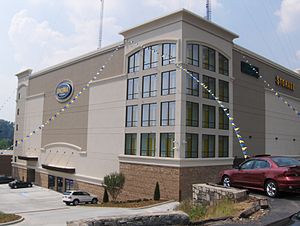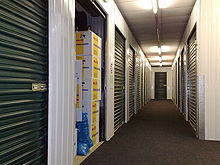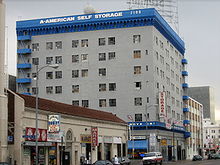- Self storage
-
Self storage is an industry in which storage space is rented to tenants, usually on a monthly basis. A self storage business provides rooms, lockers, containers, and/or outdoor space in which tenants can store and access their goods. Self storage tenants include businesses and individuals. The self storage industry is primarily a United States-based industry: of the 58,000 storage facilities worldwide in 2009, 46,000 were located in the United States.[1]
Contents
Description
The term "self storage" is short for "self-service storage" and is also known as "mini storage." Self storage facilities rent or sometimes lease space to individuals, usually storing household goods, or to small businesses, usually storing excess inventory or archived records.[2] The rented spaces are usually secured by the tenant's own lock and key. Unlike in a warehouse, self storage facility employees do not have casual access to the contents of the space. A self storage operator does not take possession or control of the contents of the storage rental space unless a lien is imposed for non-payment of rent. After a lien is imposed for non-payment, state laws generally require that storage facilities auction the contents of a storage unit to cover rent payments owed.
History
Although there is historical evidence of publicly available storage in ancient China, modern self storage facilities in which the tenant has exclusive access to the storage space did not begin to appear until the 1960s. In 1972, Public Storage built their first facility in Ej Cajon, CA.[3] Modern storage facilities grew slowly through the 90s, at which time demand outpaced supply and caused a rush of new self storage developments. From 2000 to 2005, over 3,000 new facilities were built every year.[4]
Self storage today
At year-end 2009, a total of some 58,000 self storage facilities, owned by 30,235 companies, have been developed in the United States on industrial and commercial land parcels. There is more than 2.35 billion square feet of self storage in the U.S., or a land area equivalent to three times Manhattan Island under roof. The five large publicly traded storage operators (four REITs and U-Haul) own or operate approximately 9% of self storage facilities. More recently, in many metropolitan cities where competition among storage companies is fierce, better parcels of land near residential and commercial areas are being converted into self-storage once approved by zoning panels.[5]
Self storage businesses lease a variety of unit sizes to residential and business customer/tenants. Popular unit sizes include 10x5 (10 feet wide by 5 feet (1.5 m) deep) which is about the size of a large walk-in closet, 10x10 (the size of a child's bedroom), 10x20 (one-car garage), 15x20 and 20x20 (two-car garage). The storage units are typically window-less, walled with corrugated metal, and lockable by the renter. Each unit is usually accessed by opening a roll-up metal door, which is usually about the same size as a one-car garage door. A controlled access facility may employ security guards, security cameras, individual unit door alarms and some means of electronic gate access such as a keypad or proximity card. A few facilities even use biometric thumbprint or hand scanners to ensure that access is granted only to those that rent. Self storage facility operators frequently provide 24-hour access, climate controlled storage, outdoor storage for RVs and boats, and lights or power outlets inside the storage unit as amenities to set themselves apart from competitors.
In rural and suburban areas most facilities contain multiple single-story buildings with mostly drive-up units which have natural ventilation but are not climate-controlled. These buildings are referred to as "traditional" storage facilities. Climate-controlled interior units are becoming more popular in suburban areas. In urban areas many facilities have multi-story buildings using elevators or freight lifts to move the goods to the upper floors. These facilities are often climate-controlled since they are comprised mostly, if not totally, of interior units. Warehouses or grocery stores are sometimes converted into self storage facilities. Loading docks are sometimes provided on the ground floor. Also, complimentary rolling carts or moving dollies are sometimes provided to help the customers carry items to their units. Urban self storage facilities might contain only a few floors in a much larger building; there are successful self storage businesses co-located with manufacturing plants, office tenants and even public schools.
One in ten U.S. households now rent a self storage unit.[6] The growing demand for self storage in the U.S. is created by people moving (some 40 million Americans move each year according to U.S. Census data), and by various lifestyle transitions, such as marriage, divorce, retirement, a death in the family, etc. In February 2011, 73% of storage facility owners responding to a survey by SelfStorage.com reported 2010 revenue as stable or growing from the prior year.
Self storage worldwide
According to a report (1 June 2006) by Mintel Consulting and in collaboration with the Self Storage Association of the United Kingdom space available for rental in the USA is approximately 1.6 billion rentable square feet, against 22 million rentable square feet in Australia and around 20 million in the United Kingdom. The report also states that there are around 41,000 facilities in the USA, 1,000 in Australia, around 700 in the United Kingdom and 220 in France.
Storage auctions
In the United States, self storage facilities may hold storage auctions or lien sales to vacate non-paying tenants according to their enforcement rights that are outlined within the lien law of each state. These lien auctions are open to the general public, with most bidders buying for the purpose of reselling for profit.
Often, the management of the storage facility will host the auction open to the public. However, the tenant in lien has the right to pay their bill up until the moment the auction begins and thus reclaim his/her items. Once the auction starts, potential bidders are allowed to view the contents of the space at the door by peering in. No items can be moved or touched until after the auction. The spaces are usually sold "as is". The purchaser of a unit receives everything in it and is responsible for removing the contents.
In the fall of 2010, two new television programs featuring storage auctions, Storage Wars and Auction Hunters, were released. This became an explosive trend, and the increased interest in auctions has become logistically problematic for storage facility owners.
References
- ^ http://www.selfstorage.org/ssa/Content/NavigationMenu/AboutSSA/FactSheet/default.htm
- ^ http://www.census.gov/econ/industry/def/d531130.htm
- ^ http://www.txssa.org/Publications/Mayjune1.htm
- ^ http://www.nytimes.com/2009/09/06/magazine/06self-storage-t.html
- ^ http://www.selfstorage.org/ssa/Content/NavigationMenu/AboutSSA/FactSheet/default.htm
- ^ http://www.selfstorage.org/ssa/Content/NavigationMenu/AboutSSA/FactSheet/10_Abt_Factsheet_0407.pdf
Categories:- Household behavior and family economics
Wikimedia Foundation. 2010.




